Please refer to the handbook for further detail of our project, you can find the pdf link at the end of this page.
You can find pdf version of the handbook here:
Please refer to the handbook for further detail of our project, you can find the pdf link at the end of this page.
You can find pdf version of the handbook here:
There can be two forms of scene design and sound design, real &surreal. For the real one, we can add some natural objects or decorations in the room, such as a clock, fireplace, etc. Eg. to make the emotion of leisure and happiness. We can add sounds and music, including clock ticking, fire crackling, and a piece of jazz music to build a warm environment.
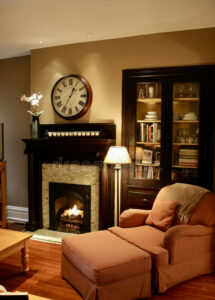
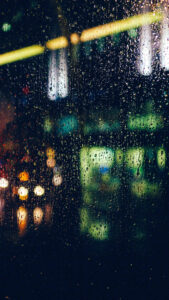
Moreover, for sadness emotion, we may set up the scene as a rainy night with some sounds of the raindrop, footsteps, crying and so on.
And the sounds and scenes can both become abstract for the surreal expression. There can be some strings, shapes, etc., with low-frequency and electronic sounds to also express sadness. And for anger emotion, we can use high-frequency electronic sounds, screaming explosions, glass shattering and so on to render the feelings.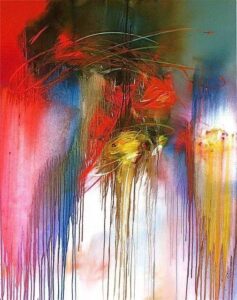
In addition, there are also other tactics and operations we can use to create immersion for players. First, we will use different footsteps for different environments (wooden floor, high-heel shoes, tile, etc.). Second, add different sounds for closing or opening the doors. For example, the sound of closing the door can be creaky and reverberate in a horrible environment.
Next, we will adjust the volume of each sound by considering the distance between the player and the object (spatial sounds). Finally, we are seeking more information and guidance about connecting Muti-channel sounds, such as 5.1 surround, in order to provide an immersive playing environment.
Ruxin and I have been discussing the possible story and narrative concept for our game. The game takes place in a non euclidean space that is designed as a maze where players must use sound to find their way through and collect clues. Each room the player enters represents some kind of memory or emotion of the playable character.
The story could go that the character in the game has fallen asleep, and as the character we enter the dreams and explore the character’s mind in this altered, dream-like kind of reality that’s in the form of this non euclidean Rubik’s cube maze. In the maze, players discover the character’s memories, and emotions that are represented in a surreal way in each room the player enters. By exploring each space, the players learn about the character’s experiences, growth, and feelings at various stages of life. During gameplay, the player uncovers more pieces of the maze, and more details about the character they are playing, with each room providing various context clues about the maze and character they’re playing.
We are inspired by the game Monument Valley, a surreal puzzle adventure game where the player guides the character through a series of optical illusions and mazes. This game has a dream-like surreal fantasy atmosphere and design with small narrative that appears once you successfully complete each level where the players get to know more about the character Ida at each stage.
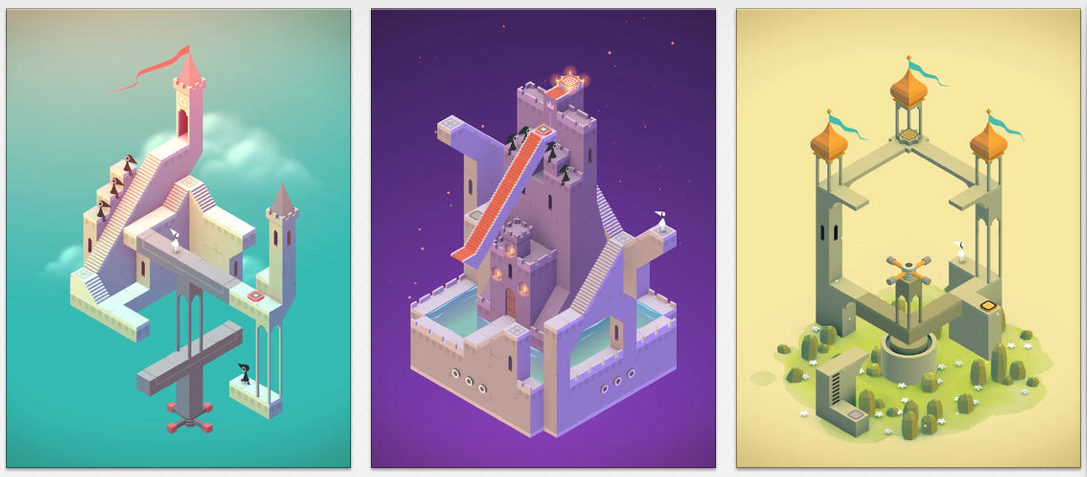

Moncage is another game that we have been inspired by, especially since this is a puzzle game that takes place inside of a cube with each side of the cube showing a different scene and it’s own unique world. In this game players are also put into this world where they have to solve puzzles that are full of illusions and clues. This game also has a dream like quality to it, and a small narrative that helps keep the player interested and engaged.
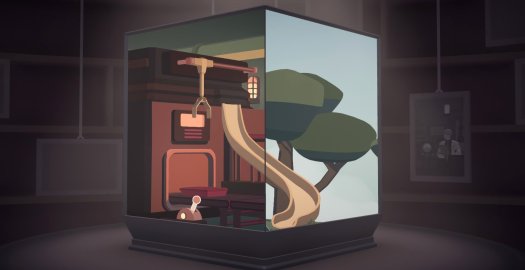 .
. 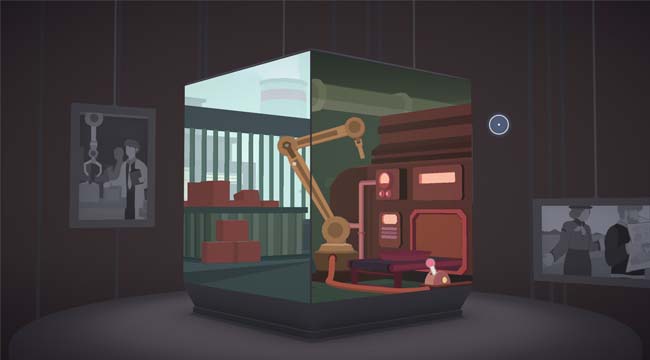
Each space of the Rubik’s Cube uses a different art style to represent character’s memories and various emotions, and each space has a specific theme. Here are some visual references for the aesthetic style of each space.
Color tone: Dark blue, orange
Sound style: the atmosphere is silence and cold. It contains the sound of dripping water, the sound of leaves when wind blows past.
Description: This room describes people’s loneliness by utilizing the concept of contrast. It will use contrasting colors to depict the melancholy of loneliness and the feeling of placing hope in something specific.

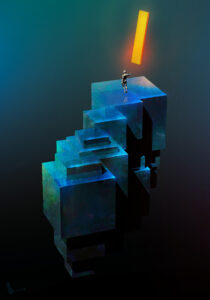
Color tone: Black and white
Sound style: Electric wave sound, the noise of people talking.
Description: Everything is in black and white in this room, and the shape is dominated by lines and simple geometry. This room will show that it is difficult for people to feel the colors and emotions of the outside world under the chaotic and anxious mood. Irregular lines can describe this psychological state.


Color tone: Various colors with high saturation
Sound style: sound effect of sunshine and breeze, the laughter of children at play, and slow music.
Description: This room will contain daily objects with bright colors. The collocation and placement of the models can be referred to Wired core. The aim of it is to create a cheerful atmosphere.
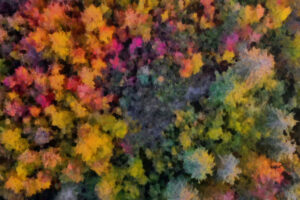
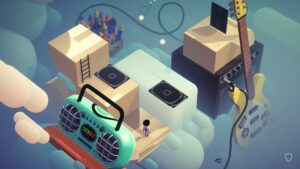
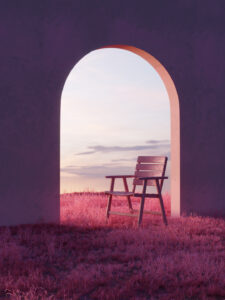

Environment: Universe
Sound style: The sound of people speaking on a radio station, the sound of a female chant, the sound effect of sand and gravel.
Description: The universe is always full of unknown and mysterious for the human. This room can be designed as a cosmic space, in which there are no living things, only abstract graphics and stars.
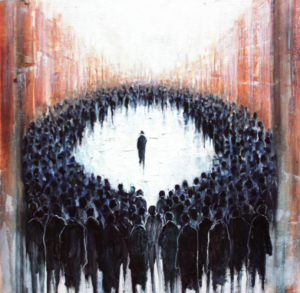
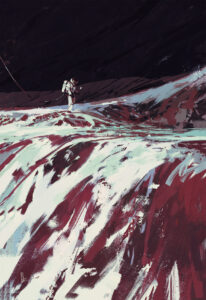
References:
Based on the ideas we discussed as a group, I created a test scenario in unity to consider the possibilities of implementation. This is a one-way transmission mechanism with only two rooms, an initial implementation
2.9 Further iterations of the project idea today
-Three rooms and two portals have been added
-The room shown in the portal is different from the actual portal destination
– The rooms are divided into blue, yellow and, at the very beginning, grey, with two portals in each room. Each portal renders an interior scene of the other two rooms depending on the player’s location. However, when the player passes through the portal, the location of the teleportation is not the room as the player sees it, which needs to be used in conjunction with the sounds that follow
Current issues:
1. As seen in the video, when the player approaches a portal in one room, the camera also renders a view of the portal in another room, which can cause confusion for the player.
2. The display screen of the camera’s render plane crosses to the outside of the room at certain locations, as the position of the camera in the room needs to be adjusted to correspond to the player’s position, so the position of the room setup becomes quite important, especially if there are 27 rooms to be set up afterwards.
3. When the teleportation occurs, there is a frame where the whole screen is flashing grey before the teleportation occurs, I tried to place the player in that position and eventually found out that it was because the player’s camera had passed through the wall of the original room a second before the collision occurred
2.13 Portal 3 Room Demo For Sub1
I made some changes to the scene to fix the previous problem.
1. I set up a collision detection mechanism to determine if the player is in the current room. When the player is in the current room, the portal in the room will only show the image rendered by the camera, and when the player leaves, the image rendering of the portal will stop, so that when the player sees another room from one room, it will not show the rendered image of both planes.
2. I adjusted the position of some cameras and collision planes, which reduces some problems during the portal through the model, but there are still some planes that have this problem during the portal.
Code explanation of function implementation:
Camera Follow
This part of the code is to make the camera set in another room follow the player’s position, and the portal is the base point to get the player’s offset value so that the camera moves to the corresponding position.
Some of the commented code in this section is intended to investigate the rotation of the camera following the player’s view, where quaternions are used to obtain the corresponding rotation angle, but it did not show good results in tests, so it was not applied at this stage, but as a direction for future research.
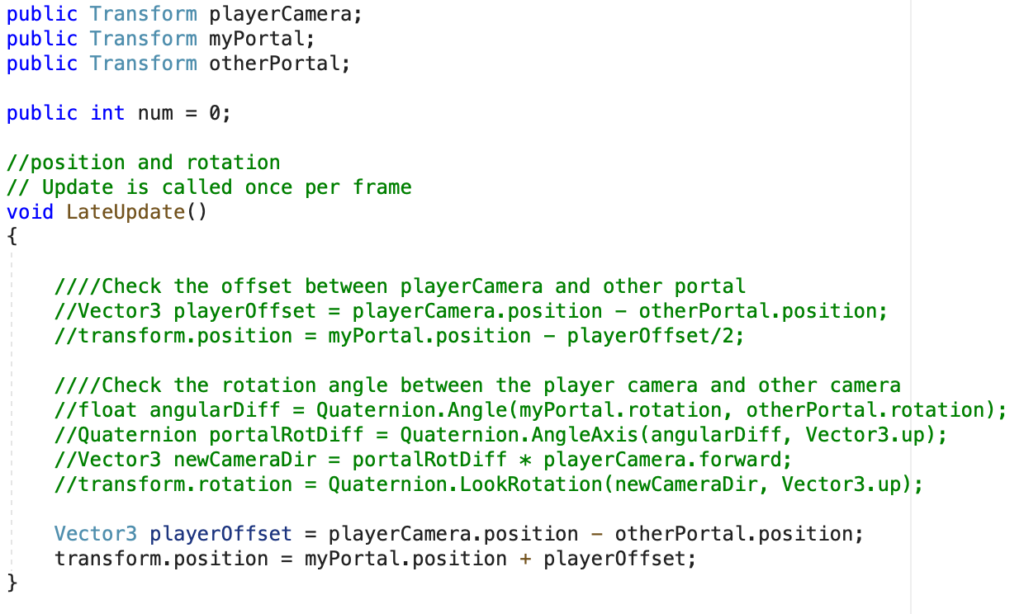
Camera Render
Shown here is how to use code to manage the image rendering material for multiple cameras. As the current camera tracking script does not implement rotation with the view, it is necessary to set up multiple cameras with different angles. Image rendering showing the plane of another room is achieved in this way.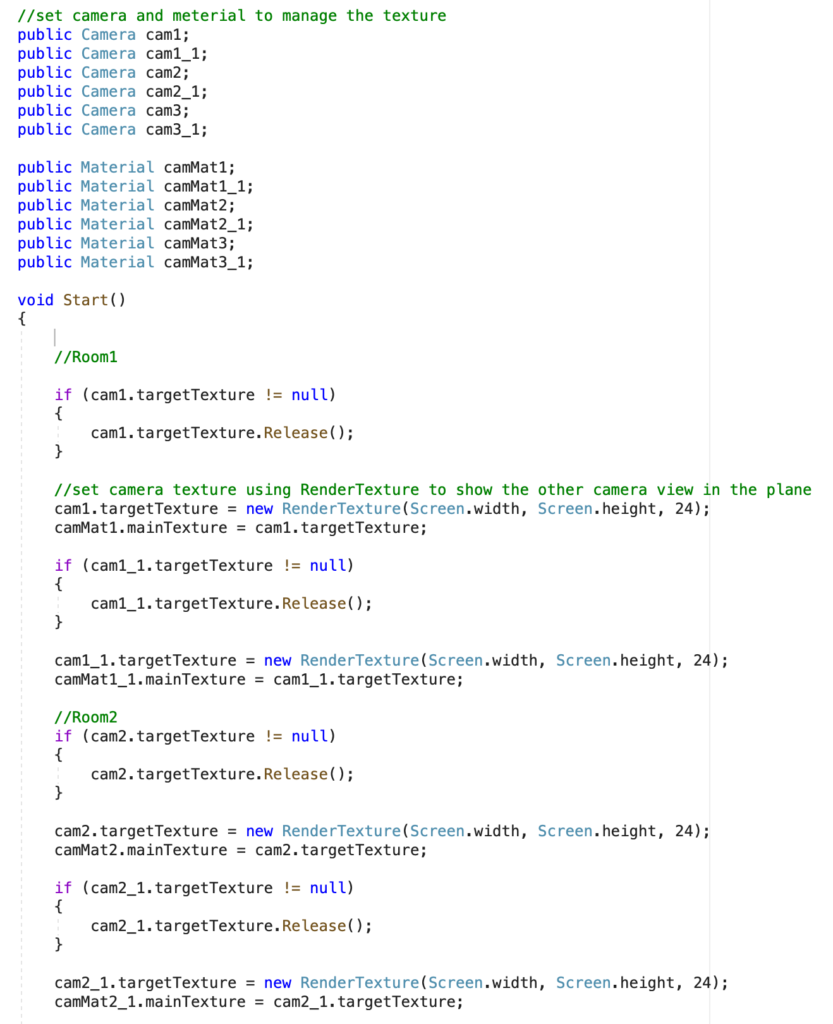
Player Detect
This is a simple script to determine if the player is in the room and when the player leaves, the portal will stop rendering the image.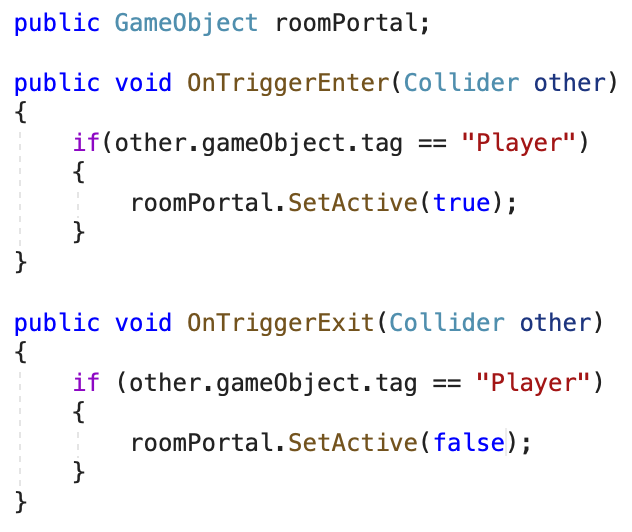
Teleport
This is a teleportation script that determines whether the player has crossed a plane by calculating the distance between the player and the door when the player collides with a collision body set up by the portal, and teleports to another place when the player crosses the plane, where the offset value of the rotation angle is also calculated by quaternions so that the player does not turn in another direction after teleportation.
The next plan:
I am going to optimize the camera’s player following logic, currently the camera can only follow the player’s movement, after that the idea is to be able to follow the rotation of the player’s head, but I have encountered a lot of problems when dealing with this part, as shown in the comments of the code, I have done some research on this part, but it is not working well at the moment.
Reference:
Mini First Person Controller
https://assetstore.unity.com/packages/tools/input-management/mini-first-person-controller-174710
Portal Tutorial
https://www.youtube.com/watch?v=cuQao3hEKfs&t=1282s
Idea of a puzzle solving game inspired by Non-Euclidean Space and Sounds
Check the outline of the ideas:
I’ve been doing research on digital art installations, some are completely virtual reality installations, while others are mixed reality and done with projection mapping. I’m also including links and images to refer back to so I can take a look at them for future reference, but also for bookmarking purposes.
Artificial Nature is a digital art installation and series that I’ve been looking at for inspiration pretty frequently. There are several different projects done by Haru Ji, and Graham Wakefield in this series that are incredibly interesting and could be useful to examine in the future. I think my favorite one is Endless Current.
https://artificialnature.net/#tab-home


The HVBRD is an audio-visual installation done by students in the Université du Québec à Montréal where they created an experience where players only goal is to cruise through a barren retro-wave landscape. The students connected a WiiFit board and customized it to move like a skateboard so players can go as fast or as slow as they want to in the experience. I really appreciated the concept behind this experience. It’s not really a video game, there’s no main goal or purpose but the player is in complete control of the experience as they cruise.
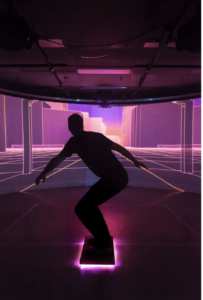
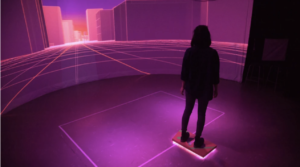
I’ve also found a website the contains entire archive of projection mapping installations, inspirations and software that we can use or that I can potentially use in the future for personal projects.
At the start of the meeting we discussed the idea of combing projection mapping with virtual reality, looking over digital installations that were done as museum exhibitions . I was the most inspired by the installation, Inhabitat , a mixed reality artwork that explored alternative ecosystems where people would be able to explore the environment in two different ways. One person could explore while wearing the VR headset and look at microscopic ecosystems up close and personal, while others could manipulate the ecosystem and play with a physical sand sculpture with a projection laid over it that was also in the room.
https://artificialnature.net
 .
. 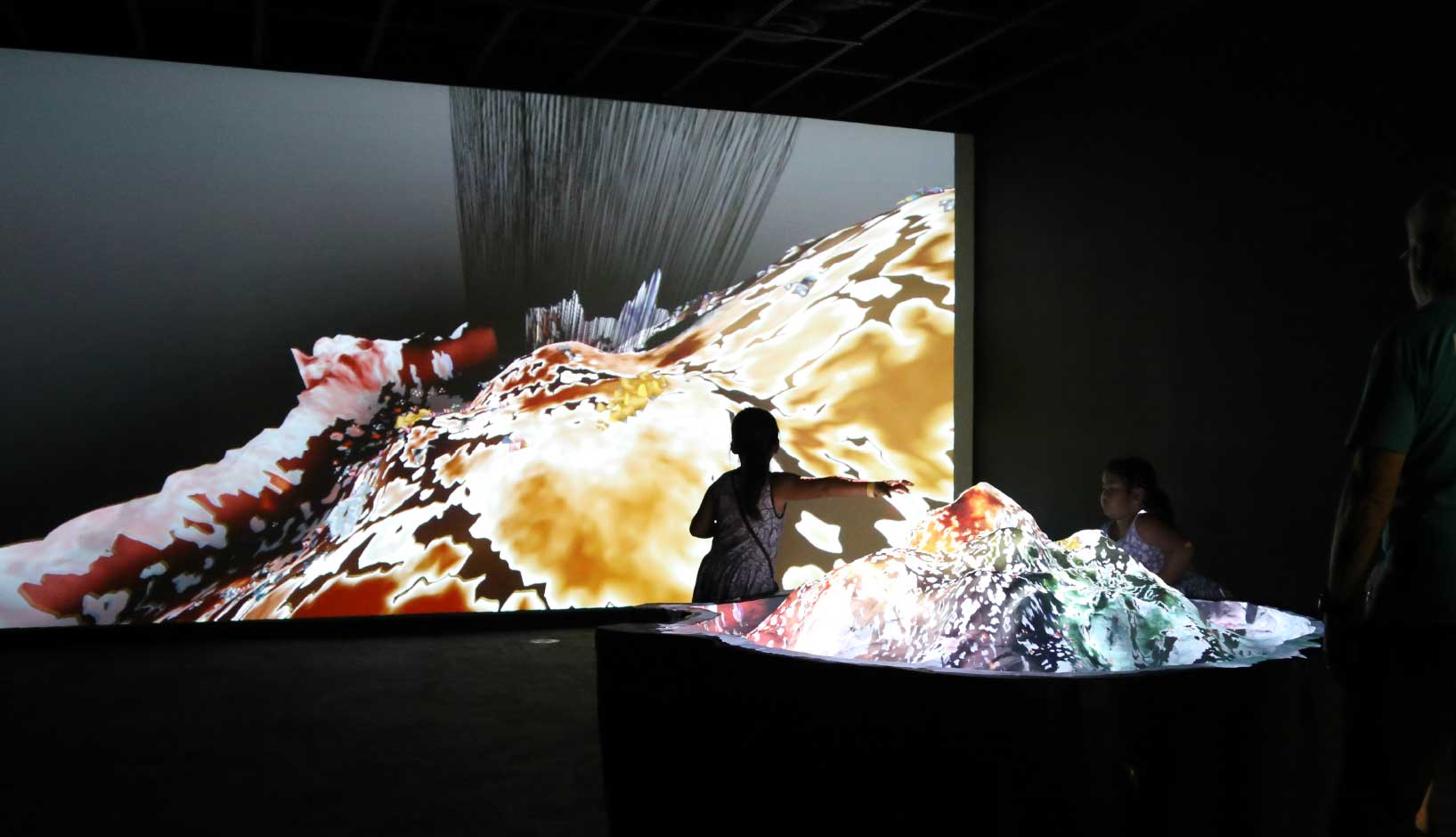
During the meeting we played with the idea of doing something similar, where we could create a world that could be seen in two different ways, and well as have some interaction with real objects and sensors by using a Vive tracker.
I’m also inspired by this installation done done by Design I/O called Connected Worlds and brought it up during our discuss. This installation was also held in a science museum, where projection mapping was used as well as physical objects. The physical objects were used by the “players” to help manipulate the environment, in addition to motion sensor technology.
https://www.design-io.com/projects/connectedworlds

Introduction of non-Euclidean engine:
https://www.youtube.com/watch?v=kEB11PQ9Eo8&list=PL_DWBKIpeitRfUUC0DgFPOG26Oui7yqyj&index=11
Examples: Rouge Noir https://www.youtube.com/watch?v=ag3vS3Lc8Ds&list=PL_DWBKIpeitRfUUC0DgFPOG26Oui7yqyj&index=10
The game can utilize the principle of non-Euclidean to design the environment and puzzles. It can combine several different spaces, and the player needs to find a way into the next space based on the clues gathered. The clue items can be physical objects.
For example, by exploring the environment, the player is given a key. But the size of the key does not match the lock. The player needs to adjust the angle of view to enlarge the size of the key to unlock the door.
Game research
This game is in the horror-adventure genre and features a blind protagonist who takes on its role to uncover the secrets hidden in an abandoned house.
The game features a visual effect of sound as the world is seen through echoes. Each time the player solves a puzzle, the environment of the scene in which they are located changes.
Some ideas for the project
Audio-based navigation
Players will use sound cues, such as footsteps, echoes, and audio landmarks, to navigate through the world. The sound will be placed in specific locations to guide players and help them avoid obstacles.
For example, players may hear their footsteps getting louder as they approach a wall, indicating they should turn in a different direction. The sound of a door creaking may indicate that a player has found an entrance to a new area.
Sound-based puzzles
These puzzles will require players to listen closely for clues and solve challenges using sound. For example, players may have to listen to a series of beeps to identify the correct sequence to open a door, or they may have to listen to echoes to locate a hidden object.